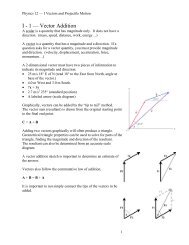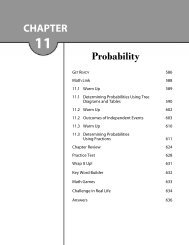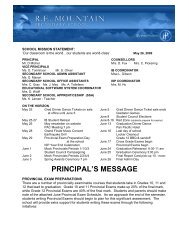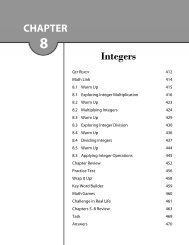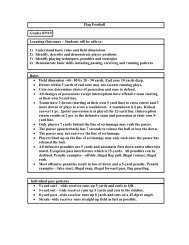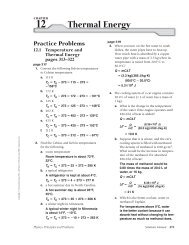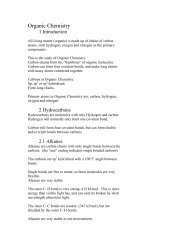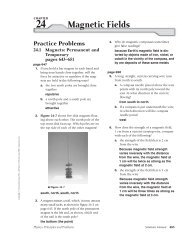Physics Solutions Manual
Physics Solutions Manual
Physics Solutions Manual
You also want an ePaper? Increase the reach of your titles
YUMPU automatically turns print PDFs into web optimized ePapers that Google loves.
Copyright © Glencoe/McGraw-Hill, a division of The McGraw-Hill Companies, Inc.<br />
Chapter 15 continued<br />
the ways in which the woods and finishes<br />
used in making violins affect the<br />
quality of the sound produced by the<br />
instruments.<br />
101. Research the use of the Doppler effect in<br />
the study of astronomy. What is its role in<br />
the big bang theory? How is it used to<br />
detect planets around other stars? To study<br />
the motions of galaxies?<br />
Students should discuss the work of<br />
Edwin Hubble, the redshift and the<br />
expanding universe, spectroscopy, and<br />
the detection of wobbles in the motion<br />
of planet-star systems.<br />
Cumulative Review<br />
page 428<br />
102. Ball A, rolling west at 3.0 m/s, has a mass<br />
of 1.0 kg. Ball B has a mass of 2.0 kg and<br />
is stationary. After colliding with ball B,<br />
ball A moves south at 2.0 m/s. (Chapter 9)<br />
a. Sketch the system, showing the velocities<br />
and momenta before and after the<br />
collision.<br />
Westward and southward are<br />
positive.<br />
Before<br />
B<br />
p B1 = 0 v A1 = 3.0 m/s west<br />
p A1 = 3.0 kgm/s west<br />
After<br />
<br />
A<br />
A<br />
v B2 = ?<br />
p B2 = ?<br />
v A2 = 2.0 m/s south<br />
p A2 = 2.0 kgm/s south<br />
A<br />
b. Calculate the momentum and velocity<br />
of ball B after the collision.<br />
Horizontal: m A v A1 m B v B2<br />
So m B v B2 (1.0 kg)(3.0 m/s)<br />
3.0 kgm/s<br />
Vertical: 0 m A v A2 m B v B2<br />
So m B v B2 (1.0 kg)(2.0 m/s)<br />
2.0 kgm/s<br />
The vector sum is<br />
mv (3.0 gm/s k)<br />
2 2.0 ( kgm/ s) 2<br />
<strong>Physics</strong>: Principles and Problems <strong>Solutions</strong> <strong>Manual</strong> 343<br />
<br />
3.6 kgm/s and tan 2.<br />
0 kgm/<br />
s<br />
<br />
3.<br />
0 kgm/<br />
s<br />
so 34°<br />
Therefore, m B v B2 3.6 kgm/s at<br />
34° north of west<br />
vB2 3.6 kgm/s<br />
<br />
2. 0 kg<br />
1.8 m/s at 34° north of west<br />
103. Chris carries a 10-N carton of milk along<br />
a level hall to the kitchen, a distance of<br />
3.5 m. How much work does Chris do?<br />
(Chapter 10)<br />
No work, because the force and the<br />
displacement are perpendicular.<br />
104. A movie stunt person jumps from a fivestory<br />
building (22 m high) onto a large<br />
pillow at ground level. The pillow cushions<br />
her fall so that she feels a deceleration<br />
of no more than 3.0 m/s 2 . If she weighs<br />
480 N, how much energy does the pillow<br />
have to absorb? How much force does the<br />
pillow exert on her? (Chapter 11)<br />
The energy to be absorbed equals the<br />
mechanical energy that she had, which<br />
equals her initial potential energy.<br />
U mgh (480 N)(22 m) 11 kJ.<br />
The force on her is<br />
F ma Fg<br />
(a) <br />
g 480<br />
N<br />
9.80<br />
m/s2<br />
(3.0 m/s2 )<br />
150 N









